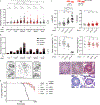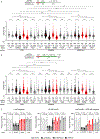BRCA2 promotes genomic integrity and therapy resistance primarily through its role in homology-directed repair
- PMID: 38244544
- PMCID: PMC11188060
- DOI: 10.1016/j.molcel.2023.12.025
BRCA2 promotes genomic integrity and therapy resistance primarily through its role in homology-directed repair
Abstract
Tumor suppressor BRCA2 functions in homology-directed repair (HDR), the protection of stalled replication forks, and the suppression of replicative gaps, but their relative contributions to genome integrity and chemotherapy response are under scrutiny. Here, we report that mouse and human cells require a RAD51 filament stabilization motif in BRCA2 for fork protection and gap suppression but not HDR. In mice, the loss of fork protection/gap suppression does not compromise genome stability or shorten tumor latency. By contrast, HDR deficiency increases spontaneous and replication stress-induced chromosome aberrations and tumor predisposition. Unlike with HDR, fork protection/gap suppression defects are also observed in Brca2 heterozygous cells, likely due to reduced RAD51 stabilization at stalled forks/gaps. Gaps arise from PRIMPOL activity, which is associated with 5-hydroxymethyl-2'-deoxyuridine sensitivity due to the formation of SMUG1-generated abasic sites and is exacerbated by poly(ADP-ribose) polymerase (PARP) inhibition. However, HDR proficiency has the major role in mitigating sensitivity to chemotherapeutics, including PARP inhibitors.
Keywords: BRCA2; PARP inhibitors; PRIMPOL; RAD51; gap suppression; hmdU; homologous recombination; homology-directed repair; stalled fork protection.
Copyright © 2023 Elsevier Inc. All rights reserved.
Conflict of interest statement
Declaration of interests The authors declare no competing interests.
Figures






Update of
-
BRCA2 promotes genomic integrity and therapy resistance primarily through its role in homology-directed repair.bioRxiv [Preprint]. 2023 Apr 11:2023.04.11.536470. doi: 10.1101/2023.04.11.536470. bioRxiv. 2023. Update in: Mol Cell. 2024 Feb 1;84(3):447-462.e10. doi: 10.1016/j.molcel.2023.12.025. PMID: 37090587 Free PMC article. Updated. Preprint.
Similar articles
-
BRCA2 promotes genomic integrity and therapy resistance primarily through its role in homology-directed repair.bioRxiv [Preprint]. 2023 Apr 11:2023.04.11.536470. doi: 10.1101/2023.04.11.536470. bioRxiv. 2023. Update in: Mol Cell. 2024 Feb 1;84(3):447-462.e10. doi: 10.1016/j.molcel.2023.12.025. PMID: 37090587 Free PMC article. Updated. Preprint.
-
RADX Promotes Genome Stability and Modulates Chemosensitivity by Regulating RAD51 at Replication Forks.Mol Cell. 2017 Aug 3;67(3):374-386.e5. doi: 10.1016/j.molcel.2017.06.023. Epub 2017 Jul 20. Mol Cell. 2017. PMID: 28735897 Free PMC article.
-
Deletion of BRCA2 exon 27 causes defects in response to both stalled and collapsed replication forks.Mutat Res. 2014 Aug-Sep;766-767:66-72. doi: 10.1016/j.mrfmmm.2014.06.003. Epub 2014 Jun 22. Mutat Res. 2014. PMID: 25847274
-
Replication Fork Reversal: Players and Guardians.Mol Cell. 2017 Dec 7;68(5):830-833. doi: 10.1016/j.molcel.2017.11.022. Mol Cell. 2017. PMID: 29220651 Free PMC article. Review.
-
Homologous recombination deficiency real-time clinical assays, ready or not?Gynecol Oncol. 2020 Dec;159(3):877-886. doi: 10.1016/j.ygyno.2020.08.035. Epub 2020 Sep 20. Gynecol Oncol. 2020. PMID: 32967790 Review.
Cited by
-
Multi-step processing of replication stress-derived nascent strand DNA gaps by MRE11 and EXO1 nucleases.Nat Commun. 2023 Oct 7;14(1):6265. doi: 10.1038/s41467-023-42011-0. Nat Commun. 2023. PMID: 37805499 Free PMC article.
-
MRNIP limits ssDNA gaps during replication stress.Nucleic Acids Res. 2024 Aug 12;52(14):8320-8331. doi: 10.1093/nar/gkae546. Nucleic Acids Res. 2024. PMID: 38917325 Free PMC article.
-
BRCAness, DNA gaps, and gain and loss of PARP inhibitor-induced synthetic lethality.J Clin Invest. 2024 Jul 15;134(14):e181062. doi: 10.1172/JCI181062. J Clin Invest. 2024. PMID: 39007266 Free PMC article. Review.
-
PARP10 promotes the repair of nascent strand DNA gaps through RAD18 mediated translesion synthesis.Nat Commun. 2024 Jul 23;15(1):6197. doi: 10.1038/s41467-024-50429-3. Nat Commun. 2024. PMID: 39043663 Free PMC article.
-
BRCA1 and 53BP1 regulate reprogramming efficiency by mediating DNA repair pathway choice at replication-associated double-strand breaks.Cell Rep. 2024 Apr 23;43(4):114006. doi: 10.1016/j.celrep.2024.114006. Epub 2024 Mar 30. Cell Rep. 2024. PMID: 38554279 Free PMC article.
References
-
- Pennington KP, Walsh T, Harrell MI, Lee MK, Pennil CC, Rendi MH, Thornton A, Norquist BM, Casadei S, Nord AS, et al. (2014). Germline and somatic mutations in homologous recombination genes predict platinum response and survival in ovarian, fallopian tube, and peritoneal carcinomas. Clin Cancer Res 20, 764–775. 10.1158/1078-0432.CCR-13-2287. - DOI - PMC - PubMed
MeSH terms
Substances
Grants and funding
LinkOut - more resources
Full Text Sources
Molecular Biology Databases
Research Materials
Miscellaneous

